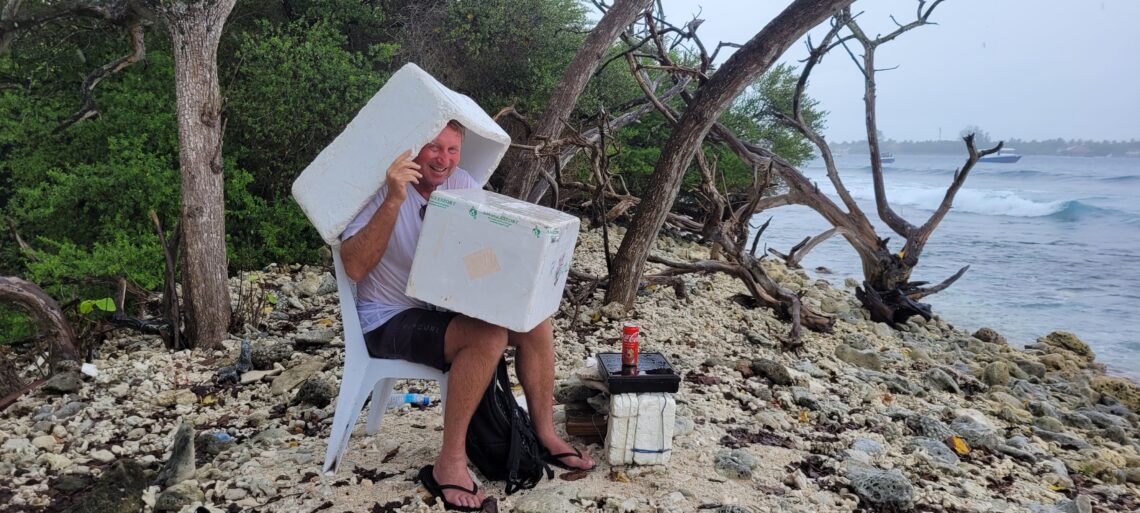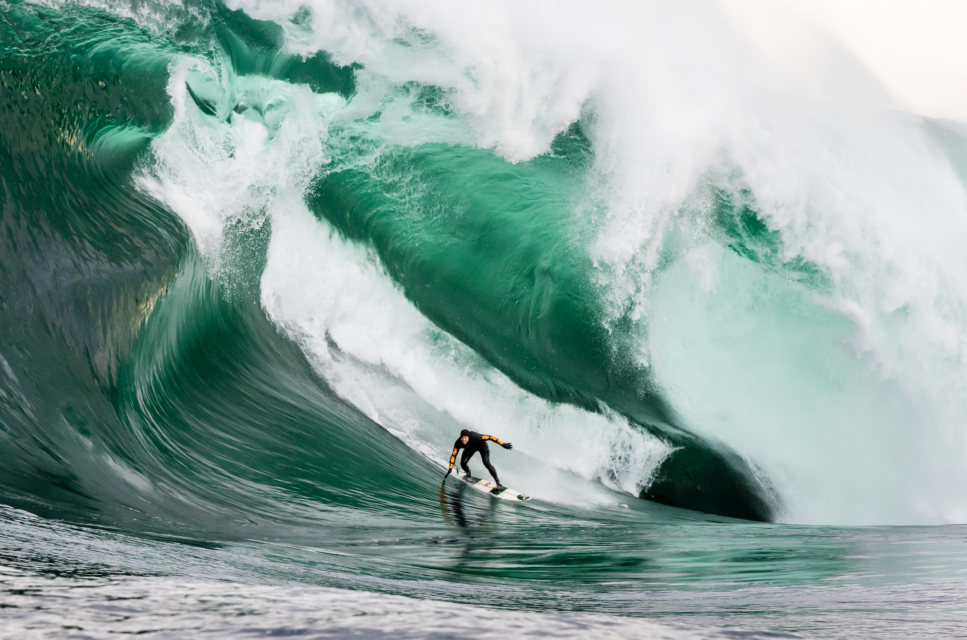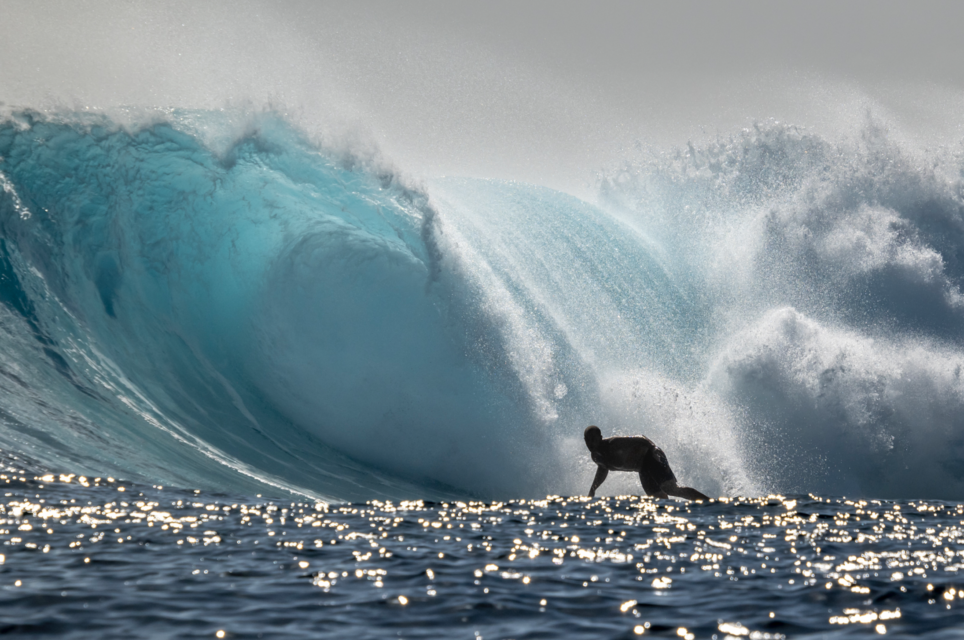TED’S LAST RUN
It's about what he leaves behind
By Sean Doherty
Late last year, Ted Grambeau pulled up in the driveway, unannounced. It came as quite the surprise. I thought he was in Portugal for starters, but hey, that’s Ted. He comes and he goes. Ted pulled up in an old hatchback with Queensland number plates that he’d driven from the Gold Coast all the way down to Torquay, a two-day drive. It struck me that I’d only ever seen Ted in hire cars and had no idea what he actually drove at home. The car was too small for his tall frame, and it took a choreographed series of movements to extricate himself from the driver’s seat. His bags and cameras were in the back seat.

Lots of questions, the obvious first. What was he doing here? Ted doesn’t need a reason to be anywhere, but I ask regardless. “Soooo… it’s little bit awkward at the moment,” he answers with a nod toward the car. “Sort of… jumping around from place to place right now.”
Ted was currently homeless, by choice. Before leaving for Portugal, he’d packed up his Gold Coast apartment, put everything in storage, and moved out. Now back in Australia he was bouncing between friends’ houses, travelling around the country at a loose end. “I’ve always got a room wherever I go,” he offered with a chuckle. “I’m finding out who my friends are, although it’s generally a three-day limit with their hospitality.” For most people, becoming homeless marks some kind of rock bottom episode, but Ted appeared to have never been happier. Home has never been home for Ted anyway.
Surf writer, Steve Barilotti used to stay at Ted’s apartment on the Gold Coast when he was visiting from California. Ted was rarely there, of course. He was always swanning off on some exotic adventure, shooting bikini models in Belize or on a solo scouting mission for surf in Cape Verde. Ted would leave a spare key under the flowerpot with the dead fern in it. Barlo would quip the only thing he ever found in Ted’s fridge was film and margarine. The apartment felt more like a hotel room. “Now I don’t even have a fridge,” Ted half-laughs. Having spent most of the past four decades on the road, Ted’s cutting all ties for one last great odyssey.
The Portugal trip was part reccy for this last great trip, but also a conditioned response. After two years of pandemic lock downs on the Gold Coast, Ted was fleeing. It didn’t matter where. “It’s the longest time in 40 years that I’ve been in the one place,” he offers. “I couldn’t really plan or do anything. That was the most frustrating thing. I couldn’t even go interstate, let alone overseas.” For a guy who’s built a life around travelling, two years confined to the suburb of Currumbin, putting the bins out on a Thursday, presented challenges to his sanity. He describes two years spent watching swell systems travelling free while he was stationery as “a special kind of torture. I was just waiting for them to leave the gate open just a touch and I was gone.”
That was Portugal. Ted left the day after Omicron hit Australia. He left with no real plan. He spent most of the northern winter in Nazaré, “photographing the ocean more than I was photographing the surf.” As Ted tends to do, he then started taking trips within trips. He woke up one morning and thought, “a snowstorm would be good” so he flew to New York to shoot one. He hired a car and drove to Norway on his own, 5000 miles in 10 days. “It was stunning. I’d just pull over, taking photos for no one other than myself.” Ted, originally a Victorian, has always had an affinity with the cold. He once described it this way – “Summer is a colour, winter is a mood.”
He then drove back to Morocco and found it eerily deserted. He’d last been there three years ago with Torren Martyn and the points had been a parking lot, lined with Sprinter vans from Europe. Not this time. “I heard there were a couple of guys from Hawaii there, but I never actually got to see them. Other than that, there were no foreign travellers down there at all.”
It reminded Ted of an earlier trip to Morocco in the late ’80s, driving an old Citroen down from Paris with Brock Little and Gary Green. They’d crossed from Gibraltar on the ferry, Brock diving overboard a mile off the African coast and swimming the rest of the way. “We didn’t have a clue what we were doing,” Ted recalls. “Brock would buy beer, Greeny would buy other Moroccan delights, and I’d drive. There was no pressure, we were just looking for some good surf and it was so easy. Word of mouth saw us end up at Anchor Point, which we didn’t really get on, but nearby there were other waves – The Boiler – that were better and there was no one there. The really good waves weren’t getting surfed because no one there was good enough to surf them.”
The Morocco trip predated The Search by a couple of years but captured the spirit of what that campaign would soon become. Ted would become a pivotal figure when it launched. He was on all the early trips, the iconic ones. Curren at J-Bay. The first Mentawai trips on the Indies Trader. Shooting alongside the late Sonny Miller, Ted captured the lost genius of Curren at his peak. Ted’s mysto lineup shots – often taken on his own sidebar trips to remote, godforsaken crumbs on a map – fuelled imaginations. Ted launched The Search as much as The Search launched Ted. It also hitched him to the surf industry just as it was taking off. A 30-year career followed as surfing’s premier travel photographer.

Ted grew up in rural Victoria, over on the east coast at Wonthaggi. A football injury in his teens saw him take up photography, but it was movie nights hosted by a group of local Cape Paterson surfers that put him on the path. They’d shot Super 8 footage on their travels to Mauritius and South Africa and other far-flung locations, and young Ted watched on, spellbound. “I’m just seeing this surf that is so perfect. Better than anything I’d ever seen,” he recalls. “These were home movies and people I knew, and I’m like, this looks pretty cool. J-Bay with no houses and sand dunes. Maybe I should go there.” Ted remembers it as “a magnetic force. I wanted to travel. I knew that from the start.”
Being Victorian, Ted had Peter Troy as a reference point. Troy’s travels by this stage were the stuff of legend, and Ted was adamant he was going to travel in the same romantic, Old-World style. Solo, overland, culturally embedded… see where the road took him. “I remember one of my first trips hitchhiking from Morocco across to Tunisia and eventually to Algeria,” Ted recalls. “No idea what I was doing. This guy’s driven me a hundred kilometres and dropped me in the middle of the Sahara Desert. No town, nowhere to stay, getting dark. I’m just sleeping on the side of the road, I guess. I thought, okay, this’ll be cool. It’ll make a good story. I fell asleep in the sand on the side of the road and of course it was cool. Very cool. I almost froze to death.”
There’s a classic self-portrait of Ted, taken with a timer in a $2.50-a-night hotel room in Penang, bathed in red light, that captures the traveller as a young man. “Penang back in the day used to be a bucket stop for cheap flights through Asia. You could get cheap standby flights to pretty much anywhere in the world. It was a crossroads. There was epic food and cheap accommodation and there were so many characters there. I guess it was on the Hippy Trail; there were travellers moving through, workers in transit, surfers, people up to all sorts of things… and I mean all sorts of things.” Ted clarifies, “Not that I frequented any of those establishments myself.”
Ted, now in his sixties, has come full circle and is in many ways closer to that idealistic young traveller now than he was at the height of his career. “I guess what my search has been about is that it’s as much about the journey as it is about the waves. People see the wave as the goal, the only goal, but seriously that’s just the end result. It’s like sex without love. The journey is what it’s all about. The whole surfing experience for me is much more sophisticated than that.”
Like most surf photographers of his era, Ted took a vow of poverty that he’s remained true to over the years. “I tend to specialise in things that don’t make a profit,” he quips. “It seems to be a theme in my life but I’m perfectly happy. Maybe when I’m gone, the financial success will be bestowed upon my nephews and nieces or something like that.” The calls from the surf brands have slowed up in recent years, but that’s also fine. Teds had a good run and remains grateful. He would have done it for free, although he wasn’t telling them that at the time.

Ted doesn’t own much. Whatever’s in the storage locker on the Gold Coast and in the back seat of the hatch. It just slows him up. An eight-month motorbike trip between Los Angeles and Patagonia taught him to travel light. Ted intends to travel even lighter on his final journey. “Other than the pharaohs, show me someone who takes everything with them.” But it’s what he intends to leave behind that is driving him now.
This brings us back to Ted in the driveway. The old bones that creaked when he got out of the car have been talking to him. “I’m relatively healthy at the moment, but the warranty’s running out,” he says. “Once you’re over 60 you start to notice a few aches and pains and I’ve realised I’ve probably got five years of serious travel left in me.” On the flipside, his eye is sharper than ever, and he sees more. “Time is ticking on my creative potential and my ability to do that sort of travel. These next five years are going to be pretty hardcore.”
What that looks like, Ted’s still not sure. He’s got a friend in Liberia he might go and see. He’s got friends all over the world he wants to catch up with one last time. Ted, ever the gentleman, is welcomed back wherever he’s been. He wants to return to trophy waves he’s shot over the years, post up for months to shoot them at their best. And he’s still a believer that there are waves out there yet to be surfed or shot. “There’s plenty left,” he says. “The world’s still there. The world’s still a big place. That’s the reason I won’t settle down.”
Full story and gallery features in SW421, available here.